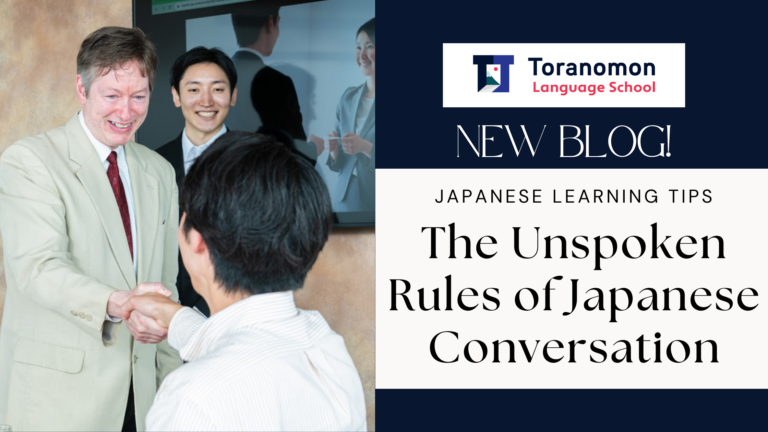
Have you ever had a conversation in Japanese where you walked away thinking, Did they just agree with me… or politely reject me? If so, you’re not alone! Japanese communication is filled with unspoken rules—subtle cues, indirect expressions, and cultural nuances that aren’t always obvious to learners. Unlike in English, where directness is often valued, Japanese conversations rely heavily on reading between the lines. A simple “yes” doesn’t always mean “yes,” silence can be a response in itself, and even your body language speaks volumes. Understanding these hidden rules is just as important as learning vocabulary and grammar.
At Toranomon Language School, we know that mastering Japanese goes beyond textbooks—it’s about learning how to really communicate. Our Intensive “Level-Up” Courses are designed to help learners quickly improve their Japanese while also teaching the essential cultural nuances that make conversations smoother and more natural. Whether you’re a beginner trying to grasp the basics or an advanced learner looking to refine your skills, our courses provide structured lessons, real-world practice, and expert guidance to help you navigate Japanese communication with confidence.
The Art of Indirect Communication: Why ‘Yes’ Doesn’t Always Mean Yes
One of the first surprises many Japanese learners encounter is that a simple “yes” (hai) doesn’t always mean agreement. In Japan, direct refusals are often considered too blunt, so people tend to soften their responses or avoid saying “no” outright. Instead of rejecting an invitation or request directly, you might hear phrases like 「ちょっと…」 (chotto…, meaning “a little…”) or 「考えておきます」 (kangaete okimasu, meaning “I’ll think about it”), which often mean “no” in a polite and indirect way. Without understanding these subtleties, it’s easy to misinterpret politeness as enthusiasm—or worse, think you’ve just made weekend plans with a coworker who had no intention of joining you!
Reading between the lines is key to understanding Japanese conversations. It’s not just about words but also the tone of voice, pauses, and facial expressions that convey the real meaning. A hesitant response, a long pause before answering, or a small sigh can indicate reluctance without the need for a direct “no.” This subtle approach helps maintain harmony in social interactions, as avoiding direct confrontation is deeply ingrained in Japanese culture. For learners, this can be one of the trickiest aspects of communication—what isn’t said is often just as important as what is. Recognizing these patterns takes time, but once you do, you’ll start to notice the hidden messages in everyday conversations.
The Magic of Aizuchi: Mastering the Art of the ‘Listening Noises’
In many Western cultures, silence while someone else is speaking is often seen as a sign of attentiveness. However, in Japanese conversations, staying too quiet can make you seem uninterested or disengaged. This is where aizuchi (相槌) comes in—short verbal responses like 「うんうん」 (un un), 「へぇ〜!」 (ehh~!), 「そうですか〜!」(Is that right?) (Sodesuka!), and 「なるほど」(I see) (naruhodo), which show the speaker that you’re actively listening. These small interjections aren’t meant to interrupt but rather to encourage the speaker to continue, creating a natural flow in the conversation. Without aizuchi, you might unintentionally make your conversation partner feel like you’re not really paying attention, even if you are.
Aizuchi isn’t just about making sounds—it also involves mirroring the speaker’s tone and level of enthusiasm. In casual settings, a friend excitedly telling a story might expect an equally animated 「まじで!?」 (Majide!? – “Seriously!?”), while in a more formal situation, a simple nod and a reserved 「そうですね」 (Sou desu ne – “That’s right”) might be more appropriate. Mastering the rhythm of aizuchi helps you blend naturally into conversations and avoid awkward pauses. It’s a subtle but essential part of Japanese communication, making interactions feel more engaging and dynamic.
The Bowing Paradox: When, How, and Why You Should Bow
Bowing is one of the most recognizable aspects of Japanese culture, but knowing when, how, and how deeply to bow can be surprisingly complicated. Unlike a handshake, which is fairly standardized, bows come in different forms depending on the situation. A casual nod (eshaku, 会釈) is used for quick greetings, while a deeper bow (keirei, 敬礼) shows respect in business settings. The deepest bow (saikeirei, 最敬礼) is reserved for moments of deep gratitude or apology. For foreigners, this range of bowing can be intimidating, but the golden rule is simple: just mirror the other person’s bow to avoid looking out of place.
Interestingly, bowing isn’t just for in-person interactions—it even extends to phone calls! Many Japanese people instinctively bow while speaking on the phone, even though the other person can’t see them. This highlights how deeply ingrained the gesture is in Japanese communication. Bowing is more than just a greeting; it conveys sincerity, respect, and even subtle social hierarchies. Understanding when to bow and at what angle can help learners avoid awkward encounters and make a positive impression in Japanese social and professional settings.
The ‘Silent Agreement’ Rule: When Saying Nothing Says Everything
In many cultures, silence in a conversation can feel uncomfortable, often prompting people to fill the gap with more talking. In Japan, however, silence is not only accepted but sometimes expected. A well-timed pause can signal deep thought, agreement, or even disagreement, depending on the context. In business meetings, for example, silence after a proposal often means the listeners are seriously considering the idea, rather than rejecting it outright. Jumping in too quickly to fill the silence might come across as impatient or disrupt the natural flow of the discussion.
Silence can also be a subtle way of avoiding confrontation. Instead of outright disagreeing, a person might simply not respond, letting the lack of enthusiasm speak for itself. This is especially common in workplace settings or formal conversations where maintaining harmony is important. Understanding when silence is meaningful versus when it’s just a natural pause takes practice, but once you become aware of this unspoken rule, you’ll start to notice how much is being communicated without a single word.
The Politeness Ladder: Choosing the Right Level of Speech
One of the trickiest aspects of speaking Japanese is knowing which level of politeness to use. The language has multiple speech registers, ranging from casual (tameguchi, タメ口) to polite (teineigo, 丁寧語) to (keigo, 敬語), as a sign of respect or to look civilized. Using the wrong level can create awkwardness—speaking too formally with close friends can make you seem distant, while using casual speech with your boss might come across as rude. Even native speakers carefully adjust their speech depending on the situation, making it one of the most important yet subtle aspects of Japanese communication.
The challenge for learners is that there’s no one-size-fits-all rule. While polite forms like 「です・ます」 (desu/masu) are generally safe, certain situations call for keigo, such as customer service or business meetings. On the other hand, speaking too politely in informal settings can create unnecessary distance. Mastering this balance requires more than just memorizing grammar—it’s about understanding social context and relationships. Paying attention to how native speakers adjust their language in different situations is key to navigating Japanese conversations smoothly.
Final Thoughts
Navigating Japanese conversations requires more than just knowing the vocabulary and grammar—it’s about understanding the subtle, unspoken rules that govern how people communicate. From the art of indirect communication to the intricacies of aizuchi, bowing, and choosing the right level of politeness, these cultural nuances can significantly impact how effectively you connect with others. The key is to listen carefully, observe, and practice until these unspoken cues become second nature. Over time, you’ll begin to notice how much is communicated through what’s not said, and how much smoother your interactions will be when you understand these hidden layers of communication.
While it may seem daunting at first, learning these cultural nuances is an exciting part of the journey when studying Japanese. The more you immerse yourself in the language and culture, the easier it becomes to understand the subtleties that define Japanese conversations. By embracing these rules, you not only become more fluent in the language, but you also gain a deeper appreciation of the culture and its values of respect, harmony, and mindfulness in communication.
If you’re ready to take your Japanese skills to the next level and master these important cultural nuances, our Intensive “Level-Up” Courses starting in March are the perfect opportunity. Whether you’re an absolute beginner or an advanced learner, our structured lessons and real-life practice scenarios will help you confidently navigate these conversational rules and improve your overall language fluency. Join us to enhance your Japanese skills, boost your cultural understanding, and communicate like a local!
Toranomon Language School
We have been helping tourists and expats living in Tokyo for years, including embassies and international corporate people and their families For adults above intermediate level eager to become bilingual and master Japanese, explore our most comprehensive 1-Month level-up Intensive Japanese courses, four days a week. Or our time and cost-efficient 2days/week “Speak-Up” Course” if you like more light-weight and conversation-focused course. You can join us in a motivating and comfortable environment where we prioritize practical application over boring old lesson styles. This course will not only help you learn how to speak confidently with essential grammar and vocab, but also with deep understanding in Japanese customs and culture. Moreover, we also give you opportunities to participate in networking events, “Walk and Learn” and other workshops, connecting with others who share your interests. We also have our renowned 4-months or 3-months JLPT Prep Course so you can ace your goal this time! We have the best teachers who can finally explain all your unsolved questions regarding grammar, kanji, or vocab, do exercises until you are confident, and efficiently learn reading comprehension and listening through mock test format.
For those who prefer personalized attention, we offer adult private Japanese classes for all levels. Whether you’re a beginner, intermediate, or advanced learner, we provide 100% customized, flexible, high-quality courses tailored to your specific needs to accelerate your learning. Our purpose-oriented approach ensures fast learning, whether you’re interested in industry-specific language, task-focused skills, or casual conversation.
And for families, our after-school Japanese for kids offers customized lessons that encourage critical thinking, fast reading and listening comprehension, or higher performance at school. Perfect for pre-school to uni students, this program nurtures both academic and personal growth.
At Toranomon Language School, we provide language learning experiences that are engaging, flexible, and practical. Book a free consultation to discover how these courses can work for you. Join us today to start your journey toward becoming bilingual!

